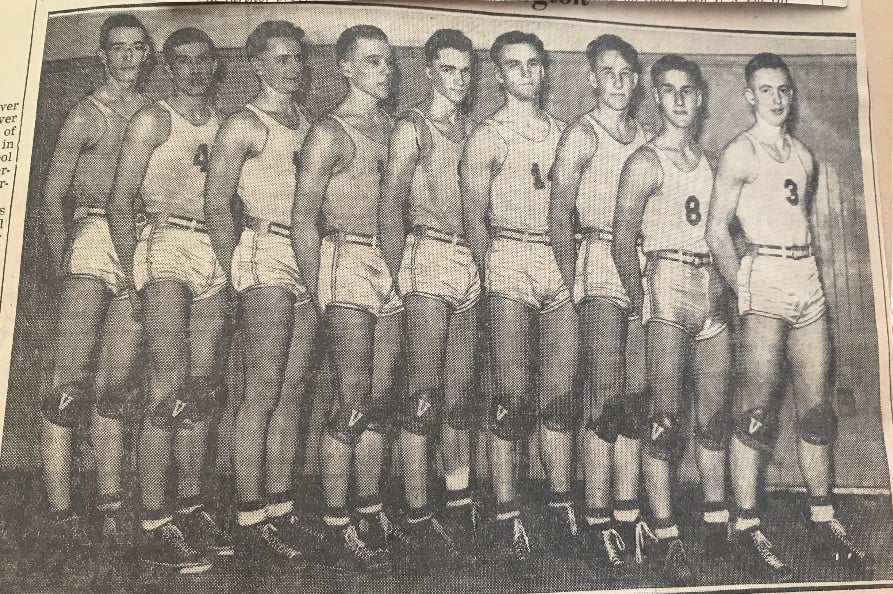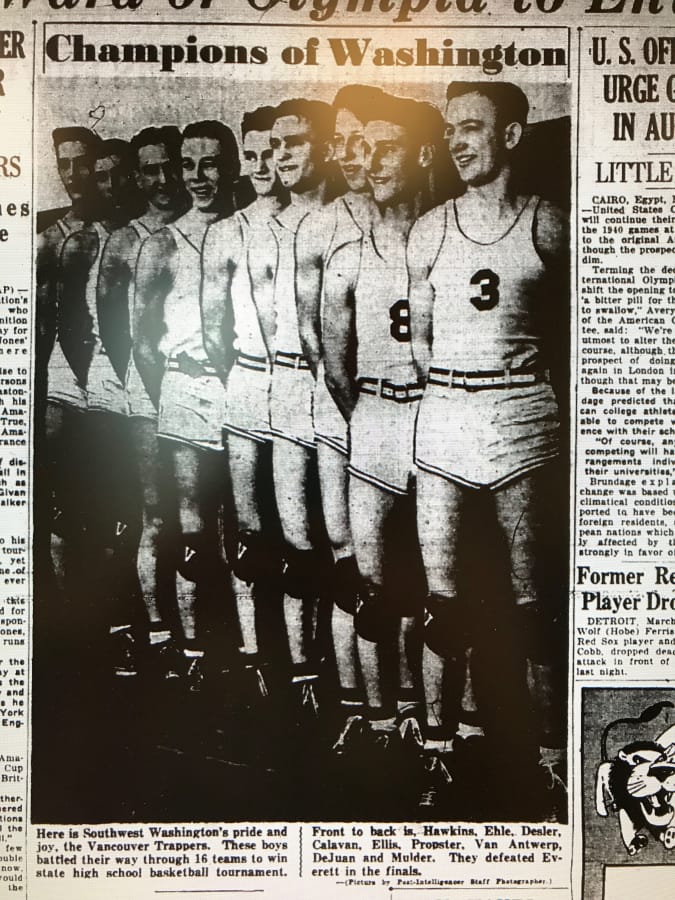Mark Mulder never met his father, who as a high school senior in 1938 starred on Vancouver High School’s state championship basketball team.
It was a team that captured by storm a city still recovering from a Depression-filled era.
Jack Mulder went missing and presumably died five days after his son’s birth on Nov. 19, 1944, when he was killed in action in Germany during World War II.
Mark Mulder, of Grapevine, Texas, recently traveled through Vancouver on his way to a vacation home in Montana. He knows about his father’s final hours in battle, thanks to a soldier’s letter.
Under the shelter of a waterproof poncho, “they shared a candy bar and cigarette. Heck of a last meal,” said Mark Mulder, an ex-Marine fighter pilot who flies professionally.
He also knows about his father’s basketball past through family keepsakes and stories.
In 1938, six years before his death, a broad-shouldered, dark-haired, 6-foot-4 Jack Mulder was an 18-year-old all-league and all-state center for the Vancouver Trappers.
Their 42-24 state-title win over Everett brought the high school, the city, and Clark County their inaugural team state championship at the University of Washington Athletic Pavilion on March 19, 1938.
Next month marks 80 years since nine boys and one coach lifted a city of approximately 18,000 during an era when at its worst, 1 in 3 were out of work. Soon after, the nation was on the brink of a second World War.
Irene (Boydstun) Miller was a 12-year-old Franklin Grade School student in 1938, and one of 10 children in her family to graduate from Vancouver High School. Her husband of 67 years, Lester Miller, whom she married in 1946, played in the band as a high school senior in 1938. Today, at 91 years old, Irene Miller still remembers an impromptu downtown rally that closed school for the day.
That’s how important the Trappers were to Vancouver. They might’ve been teenagers, she said, but the Trappers were Vancouver’s team.
“There was a lot of enthusiasm; everyone stood behind them,” Miller said. “There was a lot of city spirit.”
• • •
The stock market crash of 1929 hit the Pacific Northwest harder than other United States regions. Mills closed and labor strikes brought exports to a standstill.
Vancouver wasn’t spared. In 1934, a longshoremen’s strike at the Port of Vancouver lasted three months, proving to be the state’s most disruptive work stoppage.
It took time, but federally supported projects helped put the region back to work. President Franklin D. Roosevelt’s efforts to bring the country out of the Great Depression included construction of the Grand Coulee and Bonneville dams, employing 1,000 Clark County workers through the Civil Workers Administration. The addition of Kaiser Shipyard gave the city another employment and economic boost; many of its 38,000 employees who relocated to the area made Vancouver their permanent home.
The mid-1930s brought more success to Vancouver High School’s sports teams. Soon, such names as Jack Mulder, Worley Ellis and Claude Calavan headlined newspapers and frequented radio airwaves. Ellis also stood out in track and field as the school’s pole vault record holder. Calavan starred in football as an all-conference fullback.
If you played for Coach Marshall “Dutch” Shields, you knew this: Your starting spot was earned, never given.
Shields taught physical education and coached the school’s football and basketball teams. His teams were blue-collar, hard-working kids and drew high praise from opponents as good losers yet modest winners.
“An unusually successful (basketball) season,” in 1937, as one writer wrote, included a conference title and a district runner-up finish to qualify for state behind Worley Ellis and brothers Bob and Jack Mulder, Vancouver transplants from Quinault, a Washington coastal logging town.
Jack Mulder gave up football in 1937 to focus on a sport he eventually played at Oregon State.
That made Mulder and Worley Ellis virtual locks for starting spots again for the 1938 season as two of the Southwest Washington Conference’s fastest — and tallest — forwards.
The Trappers needed ball-handlers, though. So Shields rounded out the first-string lineup with Jack Propstra, Claude Calavan, and a soft-spoken D’Arcy DeJuan for an all-senior quintet.
Unproven to most, DeJuan would become a key piece in the Trappers’ state tournament run.
Over the course of the season, Vancouver found ways to beat every challenge thrown its way. Football and returning basketball letterman Bob Alexander left school. An emergency appendectomy made Milton Brown inactive for three weeks, and ultimately, the rest of the season. Illness hit the team so hard one week, a league game at Kelso needed rescheduling twice.
And a wake-up call came when the Trappers scored a season-low 14 points in their league opener versus R.A. Long.
That was Vancouver’s final defeat, but far from their final challenge.
• • •
Season tickets at Trapper Gym were a must-have. In 1933, a $100,000 bond passed for the addition of eight classrooms, a cafeteria, a 1,700-seat auditorium and a gymnasium in the growing high school. Construction finished in 1935.
Vancouver and Camas’ renewed rivalry made front-page headlines in January 1938, but the league-title race between the Trappers and Lumberjacks of R.A. Long made news three straight days by the time the rematch came Feb. 12 in Vancouver.
The game featured the league’s top three leading scorers: Worley Ellis, the league’s eventual scoring champion at 10.7 points per game, R.A. Long’s Kirk Gebert, and Jack Mulder. The Lumberjacks played the perfect game in a 33-14 league-opening win in Longview and when they met again, Trapper Gym was so jam-packed, as one writer wrote, “a church mouse had no room to find his cheese.”
“Eagle-eye referee McPike” whistled 34 fouls. One R.A. Long starter fouled out before the end of the first quarter, so he went for a smoke.
Jack Mulder scored 20 points in a 35-29 win, elevating Vancouver into a first-place tie with R.A. Long.
Vancouver breezed by Chehalis, Kelso and Camas the next three weeks to force a playoff tiebreaker with R.A. Long to determine the conference’s lone representative at state. School officials could not agree on a neutral location, however. Vancouver wanted the University of Portland because of its glitzy venue, size, parking, and proximity to Vancouver. R.A. Long rejected it mostly because of travel concerns.
They settled on Woodland High School and its 900-seat gym.
Admission cost 50 cents, and as expected, Woodland’s gym reached far beyond max capacity. Spectators without a seat squeezed onto the gym floor right up to the playing-floor boundary lines.
The only time Vancouver fans found time to breathe in a game described as a “combination of a football game and a track meet” came in the final minute. Vancouver won 23-17, behind Worley Ellis’ 13 points on a sore ankle that would prove to be bothersome at state.
• • •
By 1938, the state tournament reached its 15th year, but not without trying times. As the Great Depression wore on, officials canceled the 1933 tournament. When it returned the following year, the Class A and B tournaments merged into one 16-team field. In ’36, Valley High (now Willapa Valley) became the first Class B school to win state.
Qualifying for the tournament meant new experiences for the Trappers. Many had never visited Seattle.
Vancouver, like most of the 16-team field in ’38, was a Class A school. It had 935 students in grades 10 through 12. Its tournament history wasn’t as tradition-rich as that of Walla Walla, one of the pre-tournament favorites. Vancouver made its fourth state trip and had one state victory compared to the Blue Devils, the defending state champions in their 12th appearance.
But two days in, Walla Walla bowed out, and the “tall, talented, and tight-checking Trappers from the shores of the Columbia River” surprised Seattleites.
Vancouver reached the state semifinals with Lewis and Clark, Everett and Hoquiam after getting by Ellensburg (33-30) and Anacortes (29-27) the first two rounds.
D’Arcy DeJuan, the senior guard who earned a starting spot at the beginning of the season, had his first of two career-best games at state, scoring 10 points versus Ellensberg. Worley Ellis and Jack Mulder combined for 25 against Anacortes, a team that eliminated Walla Walla in what was then the highest-scoring game in tournament history (55-52).
Vancouver eyed the title game, but it meant playing two games in one day. And an unexpected off-day.
A windstorm with peak gusts of 50 mph caused a glass skylight at the pavilion to shatter, injuring multiple fans during halftime of the Wenatchee-West Valley consolation game.
Games got rescheduled for the tournament’s final day, including Vancouver’s “freak” semifinal against Lewis and Clark nobody soon forgot.
• • •
“They held the ball for 24 of the 32 minutes,” Coach Dutch Shields said.
In that same span, a smaller Lewis and Clark team of Spokane played stall-ball for 13 consecutive minutes in a 10-8 semifinal win for Vancouver that still stands in the WIAA tournament records for the lowest winning score in tournament history.
A year earlier, basketball rules changed to eliminate the center jump after every made basket.
Tied at 2-2 at halftime, Lewis and Clark pushed its lead to 7-4 before three straight baskets by Jack Mulder, Worley Ellis and D’Arcy DeJuan gave Vancouver the lead for good. The teams combined for 46 shot attempts.
By 1:30 p.m., news made its way to Vancouver that the Trappers reached that night’s 9 p.m. title game. City officials worked to get a radio broadcast through the school auditorium loudspeakers.
For those who didn’t listen on radio, they made the long trek to Seattle during pre-Interstate 5 days.
More than 3,500 fans packed the pavilion for a title game, where scorekeepers already favored Everett. In all, 10,251 paid attendees watched 26 games in four days.
The Trappers won their first three tournament games by a combined seven points, but in the title game, blew out an Everett team that twice had won games in second-half comebacks. Vancouver led 11-6 after the first quarter and 24-14 at halftime, and any comeback attempts by Everett got squelched by a Trappers team that averaged 6 feet 1.
Ernie Ludwick, Everett’s all-state guard and labeled one of the best natural shooters of the tournament, had seven points.
Jack Mulder scored 15 and D’Arcy DeJuan added 14, a new career high.
The all-state team featured Mulder (first team) and Worley Ellis (second team), and statistically, Vancouver finished last in scoring among state-placing teams (28.5 ppg).
Coach Shields, paying many compliments to his team, said three factors go into the makeup of a championship squad: players, spirit and breaks.
Credit for the spirit of the Vancouver team, the coach said, belonged to the players’ parents and what was built in their homes long before they’d get to Shields.
“Not once all season have I given them a ‘pep’ talk,” he said. “They have what it takes to go into a game and play it.
“And we made no more preparation for the tournament games than for any other.”
• • •
When the champions returned to Vancouver, celebrations began in waves.
Mayhem ensued after the 8:30 a.m. Monday victory assembly at the high school. Students burst from classroom windows. Absences far exceeded attendance. Student groups traveled as far east as Camas to demonstrate their enthusiasm. Eventually, school administrators gave in: The students won, and a champions rally formed downtown.
The normally noncommittal Coach Shields remained aglow with enthusiasm for days at banquets and private dinners honoring the team he referred to as underdogs until the tournament’s finale.
Game No. 30 on a 25-5 season was Vancouver’s exclamation point, he said.
“The boys came out from under their wraps,” Shields said, “and played their best game of the season.”
Later, Shields reflected on the 1938 state title, saying, “only once in a lifetime does a coach gets an opportunity to handle a group of boys like these.”
Nine years later, in 1947, Vancouver lost to Pasco, 52-44, in the Class A title game.
Shields became a small-business owner after leaving education and retiring from coaching. He relocated to Central Oregon with his wife, Pearl, in 1985.
The Trappers, graduating their entire starting lineup, did not qualify for the tournament in 1939.
• • •
Before Lt. Jack Mulder enlisted in the United States Army, he played for Coach Slats Gill at Oregon State — and is listed on the roster of two Pacific Coast Conference Northern Division title teams in 1940 and ’42. In 2010, Mulder’s name went on the Clark County Veterans War Memorial.
All of the letters and telegrams saved by the family of Mark Mulder, Jack Mulder’s son, remain sentimental. Lt. Smitty, who spent the final hours with Jack Mulder, sent a letter to Mark Mulder’s mother, Jack’s widow, Sybil, dated Jan. 16, 1946.
“One thing you can always know, and of which your son can be proud, is that there was never a better soldier nor a finer officer than Jack Mulder,” Smitty wrote.
Mark Mulder returns to the Northwest frequently. There are three Jack Mulders in the family. In 1964, cousin Jack Mulder led Parkrose to an Oregon high school state title. And finally, in 1992, Mark Mulder’s firstborn son, Jack Mulder, was an all-league and a first-team all-state basketball player at Tillamook (Ore.) High School.
Through them continues a basketball legacy that can be traced to a team that lifted Vancouver like few others.





